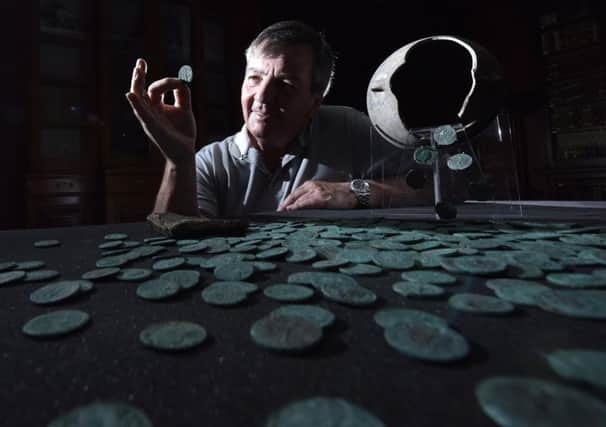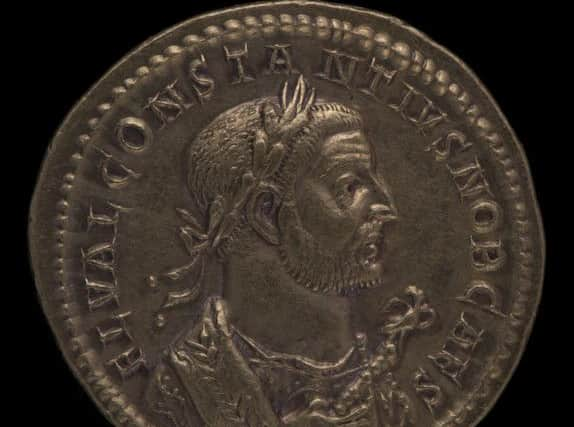Coining it in from York's game of thrones


It is sited just a few yards from one of the main doors to the Minster and a short walk away from the Yorkshire Museum where various coins and a bust of the man are on display. Now though, a discovery in a field at Wold Newton, near Driffield, will give more clues to the early years of Constantine’s reign and, more importantly, put a spotlight firmly on his father, Constantius, the forgotten emperor, who died in York the day before his son claimed the throne.
Experts hope that more than 1,800 copper coins, found buried a metre deep in a pot about the size of a biscuit tin, will unlock a few secrets in Constantine’s family tree. They might even, after 1,700 years, tell us who it was that put them there.
Advertisement
Hide AdAdvertisement
Hide AdAndrew Woods, the curator of numismatics at the Yorkshire Museum, where part of the hoard is already on display, says that nothing like this has ever been found in the north of England before.


“It is just a little amazing to think that this discovery may just well be the high point of my career,” says the 30-year-old. “It would be just incredible if anything like this happens again, and I am around to be part of it”.
Andrew was made aware of the find at the beginning of 2015 after all the complicated procedures of reporting it to various authorities, including the Portable Antiquities Scheme and the coroner, had run their course.
“I was incredibly excited from day one,” he says, “not least because David Blakey, the metal detectorist who discovered it in the middle of a field of stubble, had the sound common sense not to break it open and to disturb all the coins. They were exemplary in their discovery, and handed it over ‘as found’, and we must be genuinely grateful to them.”
Advertisement
Hide AdAdvertisement
Hide AdThe coins were stacked, almost in date order, with those minted for Claudius II (around AD 268-270) at the bottom, many from the reign of Diocletian in the middle, then those for Constantius, and the latest, of Constantine himself, at the top.


Archaeologists and forensic experts are also looking at other remains in the pot – largely remains of insects – which will tell us if the hoard was buried in a farmhouse, a barn or in a field.
In total, the coins would have been the equivalent of a year’s pay for a Roman soldier, or to put it another way, could have bought you 700 chickens, 2,000 fish, or 11,000 beers. And together, they and the pot weigh in at 20 kilos.
“This wasn’t something that was carried around,” says Andrew. “It could have been in situ and added to for years.”
Advertisement
Hide AdAdvertisement
Hide AdConstantine’s first action on reaching the top of the exceptionally greasy pole of imperial power was to march northwards out of York, and to wage war with the Picts. He urged the reconstruction of many of the strategic forts and – key to keeping a grip on communications – sanctioned the rebuilding of the road network.
His was a colourful and pretty well-documented life. We know that his mother was Helena, who converted to Christianity and was later canonised. She is remembered in Yorkshire more than anywhere else in the UK, with no less than eight holy wells or springs dedicated to her name, in places as far apart as Danby, on the North York Moors, to Gargrave, near Skipton. Among churches that bear her name is the beautiful St Helena’s, in Austerfield, in the very far south of the county.
But what of Constantine’s father? While that particular chapter in Roman history is more sketchy, we do know that he was a warrior, held the title of Caesar and was a man much respected by his troops. While his full title was Marcus Flavius Valerius Constantius Herculius Augustus, it is thought he was known to the men under his command as Constantius Chlorus, which was something of a nickname, since “chlorus” means “pale” or “white faced”.
He died at the age of 56, although no one knows of what and as the years went by he was unintentionally almost airbrushed out of history.
Advertisement
Hide AdAdvertisement
Hide Ad“It is almost certainly because his son was so illustrious, and his memory was overwhelmed by his highly successful son, and his long reign”, says Andrew Woods. “Focus has been shifted from him, and he’s become a footnote to Constantine. He is very much in his long shadow.”
We know that Constantius rested for a while in Eboracum, but his health deteriorated and he died in July, AD 306. However, some of the coins now tell us what may have happened afterwards. They show what appears to be a fire-grate, in which Romans of note were cremated after funeral rites. His son Constantine immediately raised him to the status of a divine, a god in his own right, and when he later died it is presumed his ashes were scattered within the city walls – Roman parts of which still stand about a hundred yards from the Yorkshire Museum.
“In theory”, says Andrew, “we could be standing right next to where his ashes were scattered, right now. And in the coming months and years, that hoard is going to tell us much, much more.”
Some of the coins already on display at the Yorkshire Museum, which has recently launched an appeal to raise the cash to ensure the rest of the collection stays in the county where Derek Blakey first chanced upon it. If it can’t find £44,000 by the end of October, other museums and collectors will be able to bid for it. Chances are it will find another home, probably a long way away, and Yorkshire will lose a vital piece of its Roman jigsaw.
• To find out more about the fundraising campaign to keep the coins in Yorkshire go to yorkshiremuseum.org.uk/wold-newton-hoard